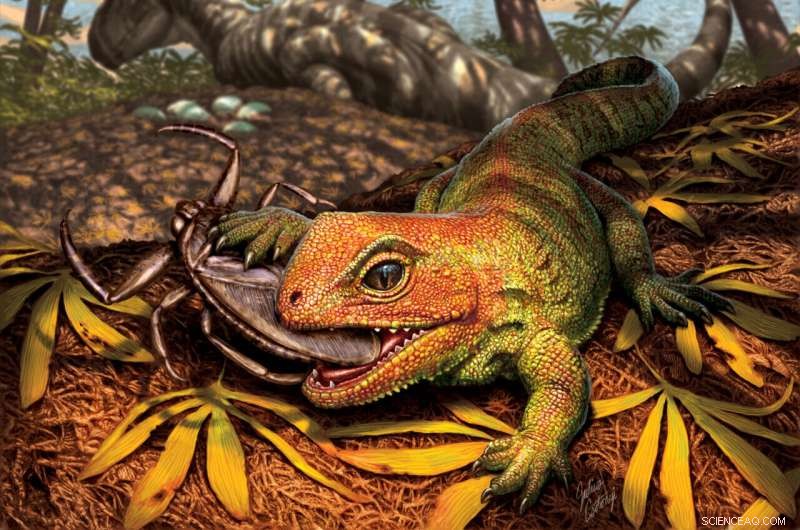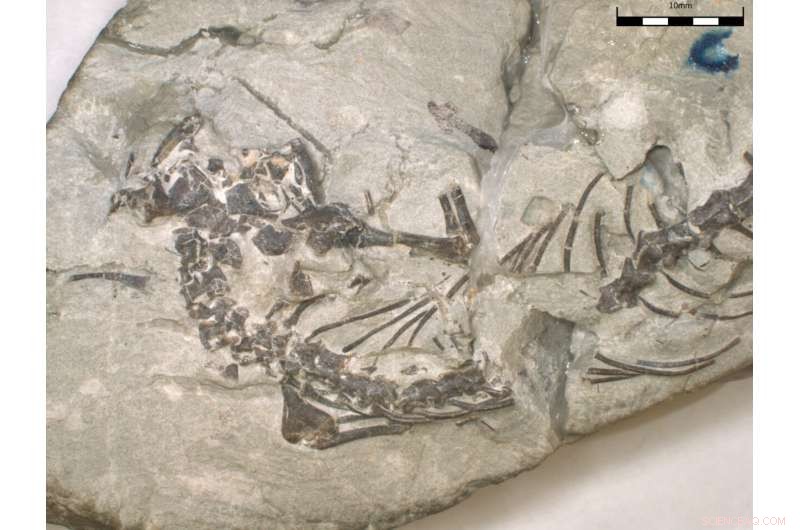
En konstnärlig tolkning av en nyupptäckt utdöd art av ödlliknande reptiler som tillhör samma antika härstamning som Nya Zeelands levande tuatara. Den nyupptäckta Opisthiamimus gregori jagar en numera utdöd vattenbug (Morrisonnepa jurassica), medan den rovdinosaurien Allosaurus jimmadseni i bakgrunden vaktar sitt bo. Scenen är översvämningsslätten i en flod i sen jura Wyoming, för cirka 150 miljoner år sedan. Kredit:Julius Csotonyi för Smithsonian Institution
Smithsonian-forskare har upptäckt en ny utdöd art av ödlliknande reptiler som tillhör samma forntida härstamning som Nya Zeelands levande tuatara. Ett team av forskare, inklusive National Museum of Natural Historys curator för Dinosauria Matthew Carrano och forskningsassistent David DeMar Jr. samt University College London och Natural History Museum, Londons vetenskapliga medarbetare Marc Jones, beskriver den nya arten Opisthiamimus gregori, som en gång i tiden bebodde Jurassic North America för cirka 150 miljoner år sedan tillsammans med dinosaurier som Stegosaurus och Allosaurus, i en artikel som publicerades idag i Journal of Systematic Palaeontology . I livet skulle denna förhistoriska reptil ha varit cirka 16 centimeter (cirka 6 tum) från nos till svans – och skulle passa ihopkrupen i handflatan på en vuxen mänsklig hand – och sannolikt överlevt på en diet av insekter och andra ryggradslösa djur.
"Vad som är viktigt med tuatara är att den representerar denna enorma evolutionära berättelse som vi har turen att fånga i vad som troligen är dess avslutande handling," sa Carrano. "Även om den ser ut som en relativt enkel ödla, förkroppsligar den ett helt evolutionärt epos som går tillbaka mer än 200 miljoner år."
Upptäckten kommer från en handfull exemplar inklusive ett utomordentligt komplett och välbevarat fossilskelett som grävts ut från en plats centrerad kring ett Allosaurus-bo i norra Wyomings Morrison-formation. Ytterligare studier av fyndet kan hjälpa till att avslöja varför detta djurs uråldriga ordning av reptiler förvandlades från att vara mångsidig och talrik i jura till att bara Nya Zeelands tuatara överlevde idag.
Tuataran ser lite ut som en särskilt kraftig leguan, men tuataran och dess nyupptäckta släkting är faktiskt inga ödlor alls. De är faktiskt rhynchocephalians, en ordning som avvek från ödlor för minst 230 miljoner år sedan, sa Carrano.
Under deras jura storhetstid hittades rhynchocephalians nästan över hela världen, kom i storlekar stora och små och fyllde ekologiska roller allt från vattenfiskjägare till skrymmande växtmumsare. Men av skäl som fortfarande inte är helt klarlagda försvann rhynchocephalians nästan allt eftersom ödlor och ormar växte till att bli de vanligare och mer mångsidiga reptilerna över hela världen.
Denna evolutionära klyfta mellan ödlor och rhynchocephalians hjälper till att förklara tuatarans udda egenskaper som tänder sammansmälta med käkbenet, en unik tuggrörelse som glider underkäken fram och tillbaka som ett sågblad, en 100-årig livslängd och en tolerans för kallare klimat.
Following O. gregori's formal description, Carrano said the fossil has been added to the museum's collections where it will remain available for future study, perhaps one day helping researchers figure out why the tuatara is all that remains of the rhynchocephalians, while lizards are now found across the globe.

Fossil skeleton of the new lizard-like reptile Opisthiamimus gregori. The fossil was discovered in the Morrison Formation of the Bighorn Basin, north-central Wyoming, and dates to the Late Jurassic Period, approximately 150 million years ago. Researchers named the new species after Smithsonian’s National Museum of Natural History volunteer Joseph Gregor who spent hundreds of hours meticulously scraping and chiseling the bones from a block of stone that first caught museum fossil preparator Pete Kroehler’s eye back in 2010. The fossil has been added to the museum’s collections where it will remain available for future study. Credit:David DeMar for the Smithsonian Institution
"These animals may have disappeared partly because of competition from lizards but perhaps also due to global shifts in climate and changing habitats," Carrano said. "It's fascinating when you have the dominance of one group giving way to another group over evolutionary time, and we still need more evidence to explain exactly what happened, but fossils like this one are how we will put it together."
The researchers named the new species after museum volunteer Joseph Gregor who spent hundreds of hours meticulously scraping and chiseling the bones from a block of stone that first caught museum fossil preparator Pete Kroehler's eye back in 2010.
"Pete is one of those people who has a kind of X-ray vision for this sort of thing," Carrano said. "He noticed two tiny specks of bone on the side of this block and marked it to be brought back with no real idea what was in it. As it turns out, he hit the jackpot."
The fossil is almost entirely complete, with the exception of the tail and parts of the hind legs. Carrano said that such a complete skeleton is rare for small prehistoric creatures like this because their frail bones were often destroyed either before they fossilized or as they emerge from an eroding rock formation in the present day. As a result, rhynchocephalians are mostly known to paleontologists from small fragments of their jaws and teeth.
After Kroehler, Gregor and others had freed as much of the tiny fossil from the rock as was practical given its fragility, the team, led by DeMar, set about scanning the fossil with high-resolution computerized tomography (CT), a method that uses multiple X-ray images from different angles to create a 3D representation of the specimen. The team used three separate CT scanning facilities, including one housed at the National Museum of Natural History, to capture everything they possibly could about the fossil.
Once the fossil's bones had been digitally rendered with accuracy smaller than a millimeter, DeMar set about reassembling the digitized bones of the skull, some of which were crushed, out of place or missing on one side, using software to eventually create a nearly complete 3D reconstruction. The reconstructed 3D skull now provides researchers an unprecedented look at this Jurassic-age reptile's head.
Given Opisthiamimus's diminutive size, tooth shape and rigid skull, it likely ate insects, said DeMar, adding that prey with harder shells such as beetles or water bugs might have also been on the menu. Broadly speaking, the new species looks quite a bit like a miniaturized version of its only surviving relative (tuataras are about five times longer).
"Such a complete specimen has huge potential for making comparisons with fossils collected in the future and for identifying or reclassifying specimens already sitting in a museum drawer somewhere," DeMar said. "With the 3D models we have, at some point we could also do studies that use software to look at this critter's jaw mechanics." + Utforska vidare